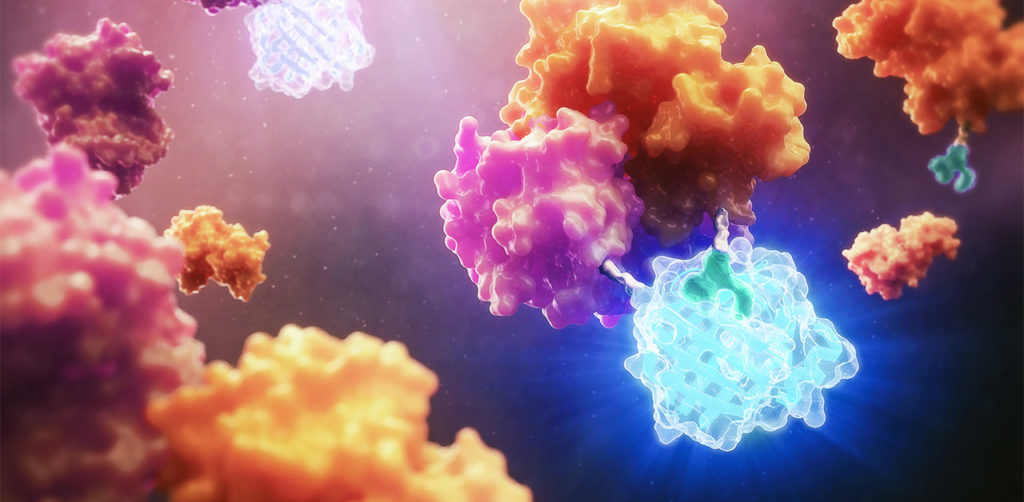
Before the COVID-19 global pandemic began, Dr. Xuping Xie, Assistant Professor of the University of Texas Medical Branch at Galveston, TX has been studying viruses, such as Dengue and Zika, for more than 10 years. Once the pandemic hit in early 2020, he was prepared to join the fight against the virus. “There was an urgent need to know: Is there a quicker way to develop therapeutics or antibodies to target SARS-CoV-2?” says Dr. Xie. “That’s why we immediately launched our SARS-CoV-2 project.”
His goal was to create an assay that could 1) screen for antiviral drugs and 2) quickly measure neutralizing antibody levels. The assay could be used to determine the immune status of previously infected individuals and to evaluate various vaccines under development. To achieve this, he wanted to create a reporter virus that is genetically stable and replicates similarly to the wild-type virus in cell culture.
Why NanoLuc?
Dr. Xie’s group generated a reporter virus by inserting the NanoLuc® luciferease sequence into the ORF7 of the SARS-CoV-2 viral genome to generate a NanoLuc®-expressing reporter virus (SARS-CoV-2-Nluc). According to Dr. Xie, using NanoLuc® luciferase as a reporter has several benefits. First of all, it is smaller in size compared to other reporters. Smaller reporters are more stable when inserted into the viral genome, and it is less likely that the reporter will be lost during virus production. This is especially important when producing a large amount of viruses for high-throughput screening.
Another benefit is that the NanoLuc® reporter virus generates a luminescent signal, which is highly sensitive and allows for a broad linear range of detection. “NanoLuc is very robust. We can achieve a very high signal-to-noise ratio, which is very important for the high-throughput assay,” says Dr. Xie. High-throughput assays that use fluorescence as the signal output usually get a much lower signal-to-noise ratio.
“The SARS-CoV-2-Nluc reporter virus we generated is very similar to the authentic SARS-CoV-2 virus, so there’s no compromise in terms of viral replication in cell culture,” says Dr. Xie. “This is very important. If you want to screen for something that targets the virus, you need a good system.”
Screening for Antiviral Drugs
In the past, high-throughput screens were often done using pseudoviruses—harmless viral particles that only express the SARS-CoV-2 spike protein and cannot replicate. Although pseudoviruses are safer to handle and can be produced quickly, they can only screen for inhibitors of the target spike protein. The SARS-CoV-2-Nluc, however, expresses all the other nonstructural proteins, so it can be used to screen for broader viral targets, such as polymerase, protease, and helicase.
Dr. Xie’s group used the NanoLuc® reporter virus to screen a broad selection of existing anti-infective drugs, including human immunodeficiency virus (HIV) and hepatitis C (HCV) antivirals. Of all the drugs tested, they identified remdesivir, chloroquine, nelfinavir (HIV protease inhibitor), rupintrivir (human rhinovirus; HRV protease inhibitor), and cobicistat (CYP450 inhibitor) as the most potent and selective inhibitors of SARS-CoV-2-Nluc. This shows that SARS-CoV-2-Nluc can be used effectively in high-throughput screens to identify antiviral drugs.
Measuring Neutralization Antibodies
The NanoLuc® reporter virus could also be an important tool for measuring neutralization antibodies. Currently, neutralizing antibodies are mostly measured using the plaque reduction neutralization test (PRNT). This involves mixing serum with the virus, then adding it to monolayer cell plates. Plaques that represent infected cells are formed after a few days, and the number of plaques is used to estimate how much antibody is present. The process is tedious and time-consuming, making it difficult for high-throughput screening applications.
Compared to PRNT, using the NanoLuc® reporter virus to measure neutralized antibodies is easier, faster, and compatible with high-throughput screening. Patient serum is mixed with the virus, then added to cells. In just a few hours, the luminescent signal can be measured using a plate reader to determine antibody levels. The results showed that SARS-CoV-2-Nluc could detect neutralizing antibodies in COVID-19 patient sera with even higher sensitivity than PRNT assays.
“[SARS-CoV-2-Nluc] is a very useful tool to measure neutralization antibodies after vaccination,” says Dr. Xie. “It’s very straightforward and the turnover time is very short. We can get results within five hours.” The ability to get results in a few hours instead of days could speed up vaccine development. He is currently collaborating with pharmaceutical companies to evaluate their vaccine potency.
Future Research
Since the fall of 2020, variant strains of SARS-CoV-2 have emerged around the world, including the UK, South Africa, and Brazil. This raises concerns about whether existing vaccines or treatments would be effective against these new strains. Dr. Xie’s team is now trying to adapt their system to rapidly screen and test antibodies against those variants. He will continue to collaborate with other groups and use his experience to help develop critical tools for the scientific community. “We need more collaborative ways to include both academia and industry to fight together and find a better solution to treat COVID-19,” he says.
See more examples of how NanoLuc® reporter viruses are used in viral research!
Reference: Xie, X. et al (2020) A nanoluciferase SARS-CoV-2 for rapid neutralization testing and screening of anti-infective drugs for COVID-19. Nat Commun.11(1), 5214
